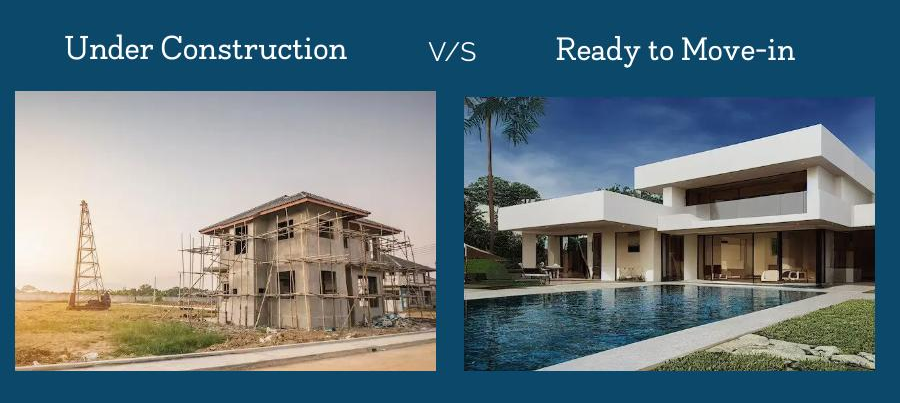THE LEADING REAL ESTATE MARKETPLACE
- 7696551555
- peoplespropertypoint@gmail.com
- 10 AM to 6:30 PM

Ready to Move in Homes vs Under Construction – When it comes to purchasing a home, buyers often face the dilemma of choosing between ready to move in homes and those that are still under construction. Each option comes with its own set of advantages and disadvantages, and the right choice depends on individual preferences, financial situations, and lifestyle needs.
In this blog, we will explore both options in detail, helping you make an informed decision. We’ll also show comparisons to further clarify your options.

Available for immediate occupancy, these residential units have completed all construction phases, including finishing touches like plumbing, electrical fittings, and more. As the name suggests, these flats are ready for buyers to move in, as soon as the purchase process is completed, eliminating any waiting period typically associated with construction or development. This option is ideal for homebuyers who need a quick relocation and prefer to experience firsthand the abode they will be living in, before finalizing the purchase.
These are residential properties that are in the process of being built, and are typically available for purchase from a developer or builder before the project is finished. Homebuyers commit to these properties based on architectural plans, models, or show flats, and they often make phased payments according to construction milestones.
When choosing between these flats, homebuyers must weigh a variety of factors to determine which option best suits their needs, financial situation, and timeline. Each type of property offers its own set of advantages and challenges.
Understanding these can significantly influence your satisfaction and financial outcomes as a buyer. Here is a detailed comparison to help you understand the differences between these two types of properties:
| Aspect | Ready to Move In Homes | Under Construction Homes |
| Price | Higher, due to immediate availability and absence of construction risks | Usually lower, as buyers take on the risks of ongoing construction |
| Possession Time | Immediate, allowing for quick relocation without any waiting period | Can vary; subject to construction progress and potential delays |
| Tax Benefits | No GST applicable if the flat has received completion certificate | Buyers can claim tax deductions on interest paid during the construction phase |
| GST | Not applicable on completed properties that have a completion certificate | Applicable, usually at a rate decided by the government, affecting the total cost |
| Customization | Limited, as the flat is already constructed. Major changes can be difficult and costly. | More flexibility in choosing finishes and modifying layouts, depending on the construction stage & builder’s willingness. |
| Risk of Delays | No risk of construction-related delays | High risk of delays due to unforeseen factors in the construction process |
| Project Completion | No risk of project abandonment; the property is already ready | Potential risk of project stalling or abandonment, if the developer faces issues |
| Quality Assessment | Direct inspection of the actual flat is possible, ensuring transparency in quality | Based on plans and show models, final quality might differ from expectations |
When weighing your options between ready to move in homes and under-construction properties, consider the following factors:
Deciding between a ready to move in home and one that’s still under construction is a significant choice that depends on many factors. Both options have unique advantages and disadvantages, making it essential to carefully assess your priorities, budget, and timeline. By understanding the implications of each choice and considering the FAQs provided, you can navigate your home-buying journey with greater confidence and clarity.
Ultimately, whether you choose a ready to move in home for its immediacy or an under-construction property for its customization potential, the right decision will lead you to the home of your dreams. Happy house hunting!
A: The timeline can vary significantly based on the type of home and the builder. On average, it takes about 6 to 12 months for a new home to be completed, but it can take longer for larger or more complex projects.
A: Yes, there is often room for negotiation, especially if the home has been on the market for a while or if you’re working with a motivated seller.
A: If there are delays, the builder is typically required to communicate with you and may provide updates on the situation. Review your contract for clauses related to delays and what recourse you have.
A: While both options can be financed through traditional mortgages, lenders may offer different terms based on the status of the home. Completed homes often have easier appraisal processes, while construction loans may require more documentation and possibly higher interest rates.
A: Changing your mind can be complicated. Depending on the stage of construction, you may or may not be able to make changes without incurring additional costs. It’s essential to discuss this with your builder and understand the terms outlined in your contract.
A: Research the builder’s reputation, check references, and visit other completed projects. Consider hiring an independent inspector to evaluate the construction process at various stages.
A: Most homes come with some form of warranty. Check the details of your warranty coverage and report any issues to the builder or seller promptly.